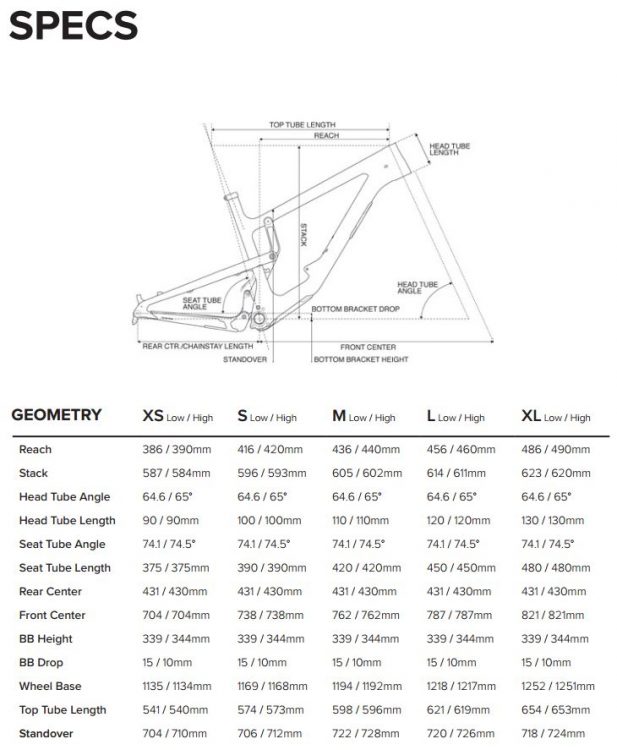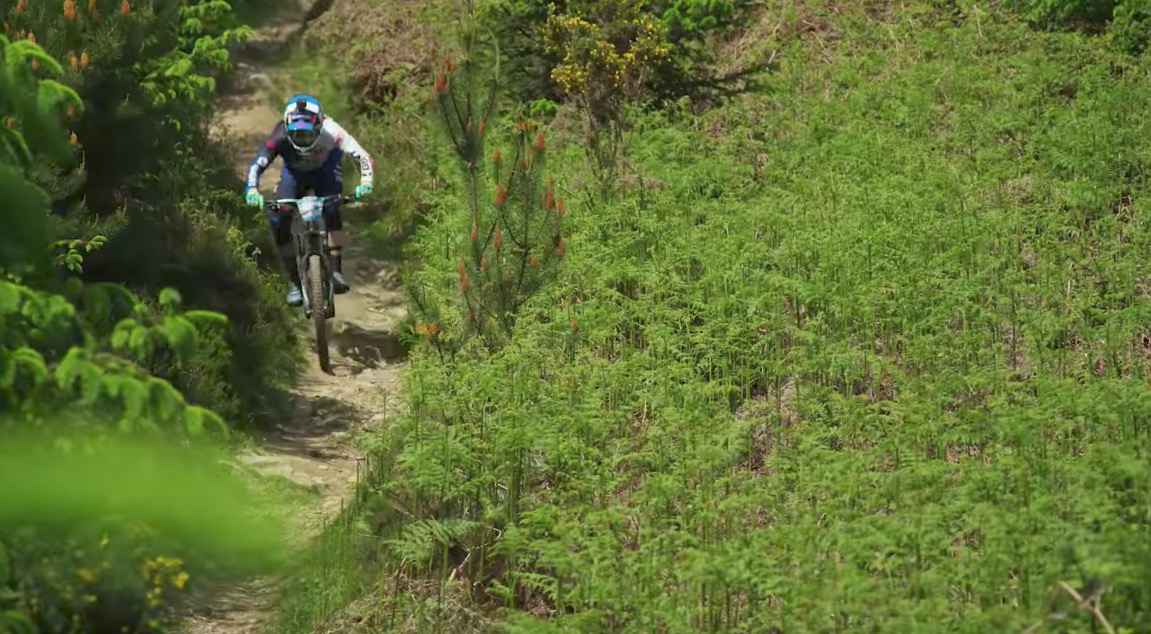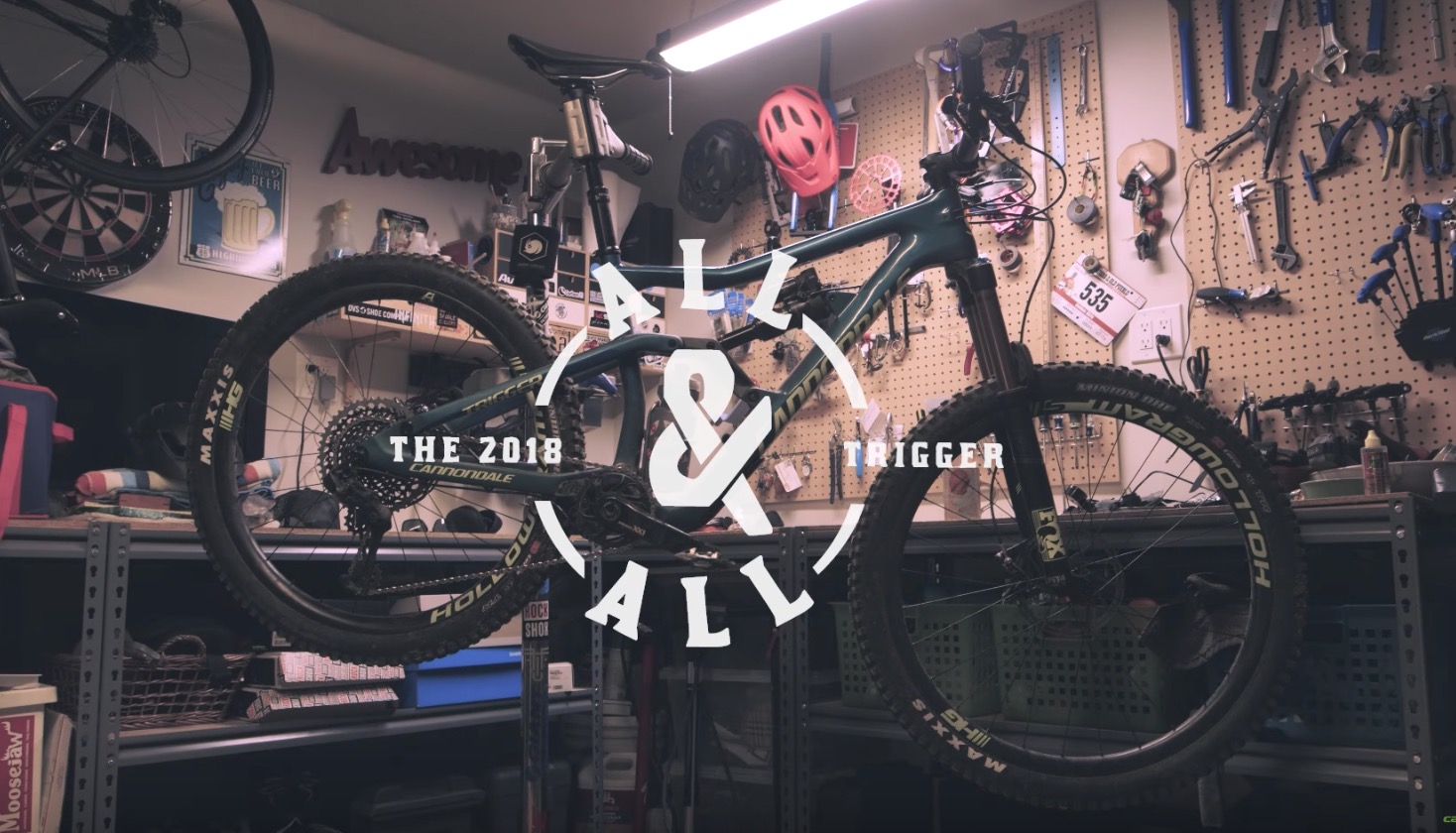Last week Santa Cruz invited us to the Italian-French border to present some news: the Nomad 4, the Juliana Strega and the carbon Reserve wheels. We spent three days riding a handful of rocky, rowdy trails near Sospel, Roja valley and Molini di Triora testing new products from the Californian brand.
The new Nomad 4
The Santa Cruz Nomad is the benchmark enduro model of the California brand. This 4th version has been completely redesigned.

Let’s start: there is no 29er…The Nomad 4 is a 27.5” with 170mm of front and rear travel; apart from the links, the frame is fully made of carbon fiber.
The suspension system is completely different from the previous version: the shock is driven by the lower link, like on the V10; this way the center of mass is kept very low.

It is not only a matter of optimized mass placement… this new scheme allows the Nomad 4 to have a totally different compression curve. While early travel sensitivity and plushness are the same, at mid-travel the suspension provides far more support. As we will see in details in the on-trail test, this significantly changes the riding behavior.
The new frame layout and its kinematics utilize a 230×60 metric shock with a standard upper mount and a bearing system on the lower shock eyelet. The bearing choice is really interesting because it allows for maximum sensitivity of the suspension on small bumps, and virtually eliminates rotational friction.
The frame can support both air and coil sprung shocks. We tested the frame with both air and spring versions of the Super Deluxe, you can read our thoughts and comparison further down.

The geometry of the Nomad has also changed a bit. To have an efficient pedal stroke and an ideal climbing position, engineers chose a rather steep 74/74.5° seat angle. The head angle is 64.5/65°, almost on par with the previous model. The 430mm rear triangle is quite short. The bike comes in 5 sizes from XS to XL with virtual top tube lengths ranging from 540mm to 650mm.

Moving a small eccentric, it is possible to adjust the geometry between two positions. In low position there’s only a slight difference since the bottom bracket is a little lower and the seat and head angles open up by just 0.5°. Trying out the two configurations, we only felt a bit more stability in the low position.

The rear brake mount is a 180mm Post Mount. It’s possible to outfit a 180mm rotor with your most brake systems without an adaptor, thus reducing the weight while also muting vibrations and resonance.
The rear wheel is Boost 12x148mm and the rear triangle can support up to 2.6” tires leaving enough space to prevent mud buildup.
The routing is quite peculiar. While the shifter and the dropper post cables run inside the frame, the rear brake cable is completely external. This choice has been made to ease maintenance and to enable a quick brake swap in case of a problem. Shifter and dropper post housing are completely hidden and come out right alongside the shock. The Reverb cable routing is fully internal, going into the frame at the front. During the 3 days of riding we didn’t notice any noise or have any problems due to the internal routing.

The lower frame is very well protected. Near the bottom bracket there is solid rubber protection fixed with two screws. It is slightly detached from the frame in order to absorb violent impacts without damaging the frame.

The “shuttle bumper” is a new protection to avoid scratching the bike loading it onto pickup trucks.

The chain stay is also very well protected by a rubber fitting, which is reinforced with a metal plate on the upper part, close to the chainring and the bottom bracket.

Last but not least, the shock’s mudguard. Given the shock’s position, this feature does serve a very important job.

The Nomad can comfortably host a water bottle, thanks to the front triangle’s clean, roomy design and the shock’s new, lower position.
This is a well finished and supposedly long lasting bike, it is not by chance that Santa Cruz provides a life-long guarantee for their frames.
The new Juliana Strega
Santa Cruz also take care of the ladies who love to ride…They offer a dedicated women’s version: the Juliana Strega.

The Strega has the exact same geometry, technical features and specs of the Nomad. A really high-level bike designed for women. Who says a girl’s bike should be lower level men’s bike anyway? The Juliana Strega and Santa Cruz Nomad are pretty much identical.

The Strega has a different shock tune: a Low-Low instead of a Mid-Mid. This is because, typically, women weigh less than men and inherently set their suspension with lower pressure values. Therefore, their compression and rebound damping must be less intense in order to work better with said lower pressures.

Size being equal, Strega and Nomad have exactly the same geometry. The only difference is that Strega is available only in the XS, S and M size.
New Reserve wheels
Santa Cruz also launched a new project: the Reserve wheels.

The Reserve are the first wheels developed by Santa Cruz and will be available as an upgrade for the top-level builds.

The core of the project are the new carbon rims, they’ve been developed by Santa Cruz with the same building techniques used for their frames. The output is a very well finished, hookless, asymmetric, low-profile carbon rim. The most amazing thing, looking at the sections, is how well the inner part of the rim is finished: it is perfectly smooth with no processing remains. The chief engineer explained to us that they worked fervently on this aspect, because a smooth and regular surface is more solid and resistant, and of course it looks better.

The goal of this project was to build the most durable, solid and reliable carbon wheels, which also satisfies the average rider’s needs. The low profile makes the wheel feel compliant vertically, so that on harsh terrain it is less nervous and transfers less feedback. The material has been moved to the (hookless) profile zone, which is quite thick and rounded. This way the rim is way more resistant to impacts from rocks & pebbles, and thus the risk of punctures is reduced.

The rim is reinforced around the nipples. These thicker areas protrude externally not only for aesthetic reasons, but mainly because in this way, the inner rim profile is smooth and therefore more solid.

The hubs installed are either DT350 or Industry Nine Torch. Both are proven, top notch and highly-reliable hubs.

The set is laced with 28 DT Swiss Competition Race 3x crossed spokes (butted 2-1.6-2), with Secure Lock aluminum Sapim nipples.
The following sizes will be available:
- 29”: 25, 27 and 30mm inner channel
- 27.5”: 27 and 30mm inner channel
The wheels can be purchased optionally with a top level Santa Cruz build kit or aftermarket to be installed on any bike.
On trail: Nomad 4 with Reserve wheels
Santa Cruz not only showed us their new products, but gave us the chance to test the new Nomad 4 over the span of 3 days of riding near Sospel, Roja Valley and the beautiful Molini di Triora (France and Italy). Three days of intense riding: up with shuttles and down on rocky and twisty trails with big gaps, through dust and rock layers. 15,000m of downhill with no rest: a solid test for the Nomad 4!

The bike we rode was a Nomad C, size Large (1.83m rider), XX1 build with 27.5” Reserve:
- 170mm Lyrik RCT3 Boost fork
- Super Deluxe RCT shock (both air and coil sprung versions ridden)
- 150mm Reverb dropper post
- X01-XX1 group
- Reserve wheels on Industry 9 Torch hubs, 30mm channel
- New 180mm SRAM Code disc brakes
- Maxxis Minion DHF 27.5×2.5 tires. EXO TR 3C version at the front and DD 3C maxxgrip at the back
We set the shock according to the Santa Cruz technician’s advice, and we must say they instantly found a near perfect setup. We started with a 30% sag and the compression set on 1 out of 3 available clicks. We just had to close the rebound by a few more clicks after the first run, since it was too fast. We already had our setting for the Lyrik so we played it safe.

After we set up the bike, we jumped on the shuttle, eager to satisfy our curiosity about the new bike. We had to pedal a bit from where the shuttle left us at the beginning of the track. The first impression was good. The bike, despite its 170mm of travel, doesn’t sink or wallow at all while pedaling. The pedaling was smooth also without the lock; no bobbing issues, unless out of the saddle, but that’s to be expected. Given the geometry with the steep seat tube, the riding position is nice and upright. On steep ground in fact, the bike climbs really well, little by little it overcomes every obstacle. With the XX1 Eagle 32-50 you can climb up everything, but the most incredible thing is that the bike doesn’t bog into the travel nor front-wheel-lift that much. On the contrary, the front wheel stays on the ground even better than some other bikes with shorter travel.

Descents equal fun! You immediately feel safe: the Nomad is an intuitive bike, not overly reactive or too nervous. You get on it, get used to the geometry, the riding position and feel comfortable right away. It is very stable on straight sections but yet it corners well in the tight bits. Usually, modern bikes with such slack angles and long virtual top tubes, tend to be lazy in tight turns. Not the Nomad: you just need to load the front properly, lean out and when you enter the corner just let it flow…the bike will follow suit and turn smoothly.

The trails of Sospel are a mix of pedal sections, with twisty and technical, trials-like sections. There are also with some very fast parts where you basically float through the rocks. That was where the versatility of the Nomad shined: it always rode very well, and never let us down.

Having gained some confidence, I tried to take it to the limit. I found a good sized drop with a not so clean landing. While jumping, I realized I was going to land in some rocks. I was a bit worried, because I was wearing an open-face helmet and soft knee pads, but the re-entry was perfect. The bike soaked up the less than ideal transition with no problems, like nothing had happened, its quite comfortable in the air!

Also on big bumps you feel pretty safe on the bike: the rear never sinks too much, it tends to float and it is always ready to face the next obstacle. While braking it is neutral and super stable under the most violent braking sections.

In comparison with the previous version, you can clearly feel the different compression curve. I don’t know exactly if it is due to the shock, or the frame, or both, but the Nomad 4 provides far more mid travel support. This means the bike almost never wallows in the travel, not while pedaling and not in the most rocky and bumpy of sections. Initial sensitivity is good as always, the biggest change is at mid travel. You can clearly feel it facing back to back obstacles: the bike recovers well from successive mid sized hits without losing speed.

Since I was curious about the adjustable geometry, I also tried the low setting. Given the type of trails in Provence, I’ve always ridden in high position to have a bit more agility in the tight French turns. At Molini, where you have more wide open corners, I tried the low position, but, honestly, I found very little difference. The bottom bracket is slightly lower and the head angle slacker, but these don’t affect the overall behavior of the bike too dramatically.
I also tried the coil sprung shock comparing it with the air one. I was expecting big differences but the increase in plushness was not that drastic. You can feel that the suspension is a little softer at early travel, but on medium and big hits the difference is minimal. A more detailed test will be carried out, but the first impression is that the air sprung Super Deluxe works really well.

What about the wheels? On the trails we rode, the wheels have been stressed a lot, but among 30 bikes there had been no wheel issues…A lot of flat tires but no rim damage.

The wheels conveyed a very positive riding feeling. On one hand they’re not that stiff; you can easily pop off every little trailside obstacle thanks in part to their liveliness, but on the other hand they have loads of lateral stiffness. It is hard to evaluate wheels after a couple of rides, especially on a new bike, but our first impressions are really good!
Conclusions
All in all, the new Nomad more than matches the performance level of its predecessor. The target of the Nomad 4 is the extreme Enduro segment. You can pedal fairly well on trails with a lot of vertical, but the main goal is to go fast downhill. Carbon wheels are a good upgrade for those who want to earn it, and can afford it. From a freeride perspective, the Nomad is a worthy bike on the all natural trails. It can also hold its own riding bike parks, but it gives shines brightest on natural terrain.

Perhaps the best thing about the new Nomad is its all-round character. You can do everything with this bike, from enduro races, to the Sunday rides with your friends, Alpine trails, and freeride with shuttles. The bike is downhill oriented, so it’s aimed to have fun descending, whether doing so after pedaling or after grabbing a shuttle to the top.
It’s a bike for everyone, easy to ride, well balanced, conveys a good feeling from the first ride and doesn’t whimper even in the most extreme situations, it always asks for more. It suits riders of every level: from those looking for a bike that makes them feel safe on the downhills to those who want a monster truck.
Specs & Prices

Photo credits: Sven Martin – Santa Cruz Bicycles








